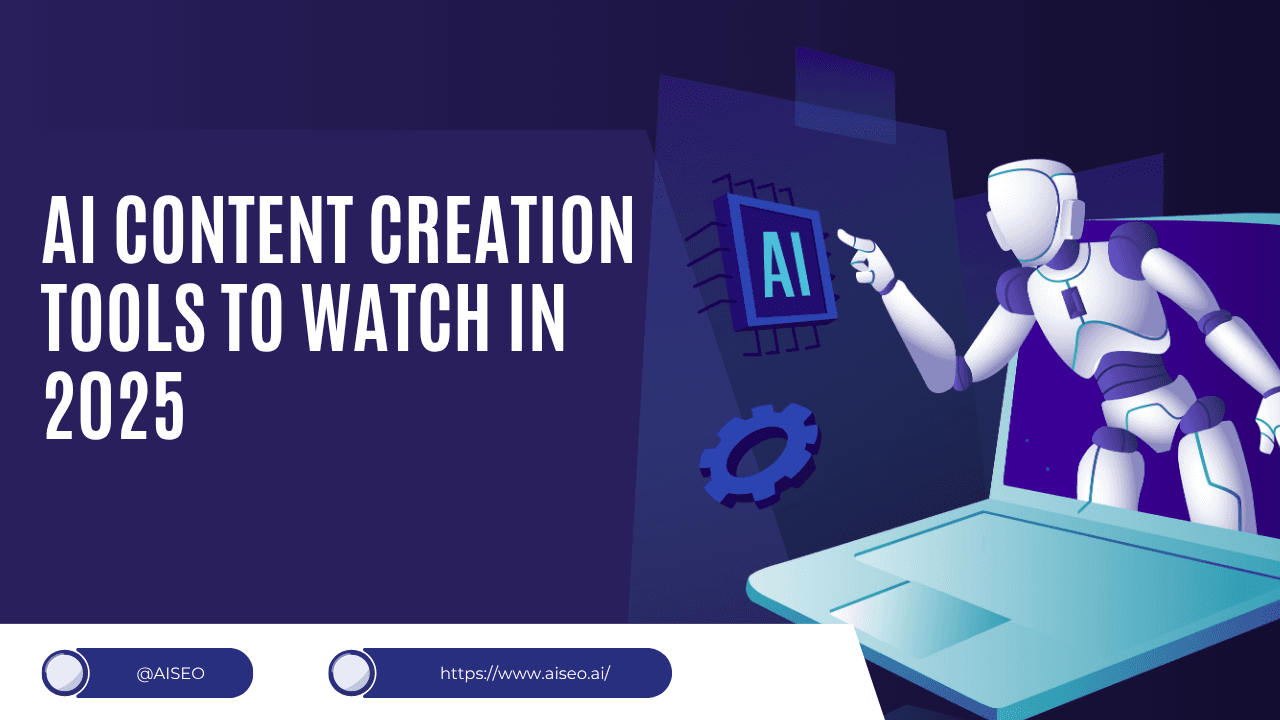Whether you’re a solo creator or part of a full-stack marketing team, here’s the reality: content no longer wins on effort alone. It wins on strategy, speed, and smart execution — and that’s where AI content creation tools come in.
In 2025, these tools don’t just “write.” They research, draft, edit, optimize, and even fine-tune your tone so your content feels authentic, not automated. But with hundreds of options promising the same results, choosing the right stack can feel impossible.
That’s where we come in. We’ve tested, compared, and broken down the top AI content creation tools shaping how professionals work this year — so you can skip the confusion and focus on results.
⚠️ Disclaimer: This isn’t a sponsored lineup, and the order doesn’t reflect ranking. Each tool was reviewed for real-world usability, accuracy, and performance based on publicly available data.
From all-in-one platforms to specialized assistants, these are the tools that actually move the needle. Let’s dive in and find the AI co-writer your content deserves.
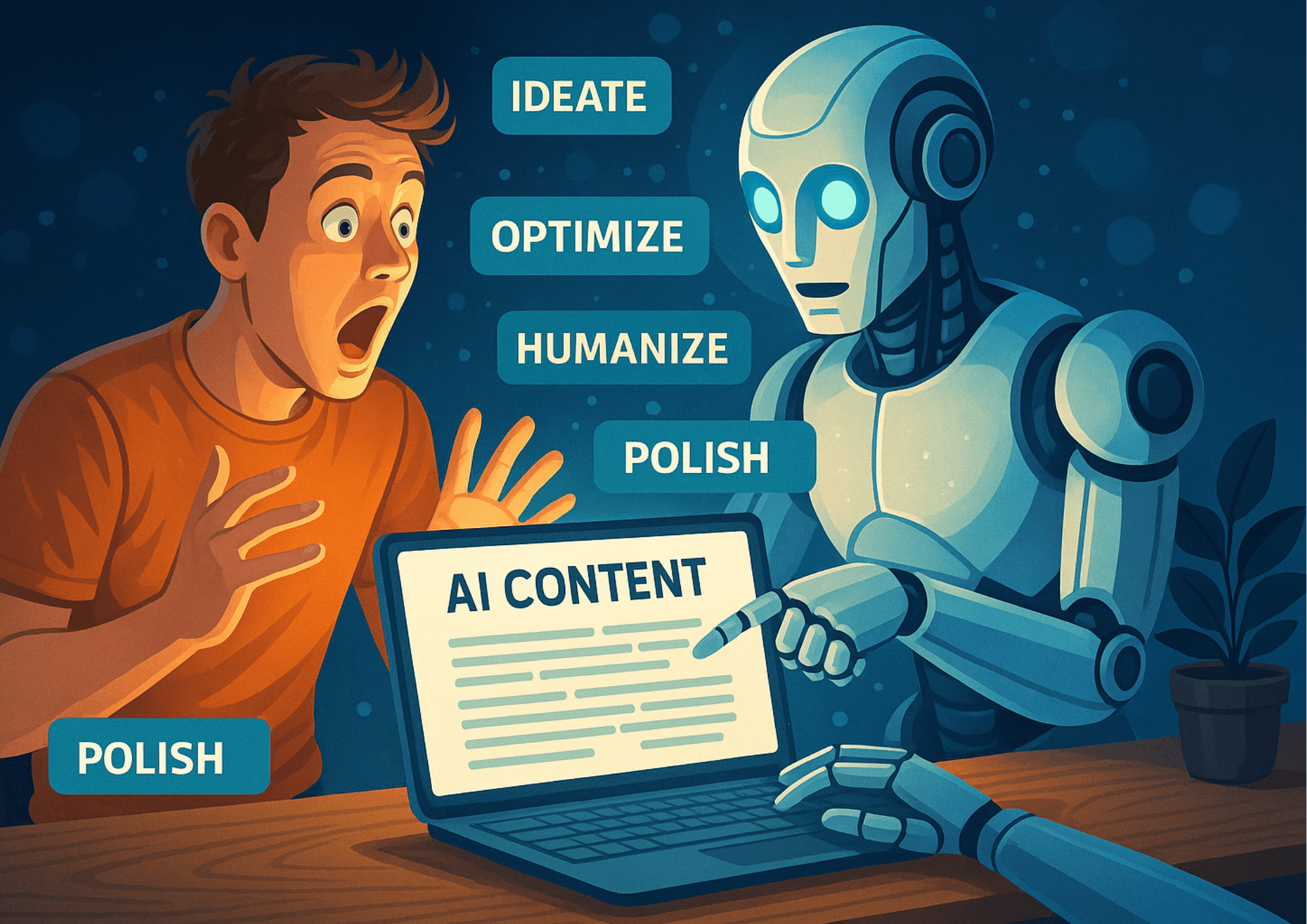
Best AI Content Creation & Editing Tools to Try in 2025
Here are some of the top tools in the space, covering different stages of the writing process. (Yes, ChatGPT is in here too — it’s still a backbone.)
1. Humanize AI Text
Most AI content tools help you write faster but the result still sounds like AI. Sentences feel too perfect, tone is flat, and AI detectors can flag your work — especially in SEO, academics, and business publishing.
Humanize AI Text fixes that in one click. It transforms robotic AI output into writing that flows naturally, carries emotion, and feels like a real person wrote it. For creators publishing AI-assisted content, this tool is essential — not optional.
💡 Pro-tip: If you want AI efficiency without losing authenticity, Humanize AI Text gives your writing the human touch required to pass AI detection while staying engaging and credible.

⚙️ Key Features Content Creators Love
🧑💻 Natural, Conversational Rewrite Automatically restructures AI-generated content to read smoothly and emotionally, like a genuine writer created it from scratch.
📄 Full Document Humanization Upload PDFs or Word Docs — formatting, spacing, tables, and citations stay intact while the text becomes fully humanized.
🔍 Plagiarism-Safe Writing Removes repetitive language patterns that trigger plagiarism and AI originality checkers.
📈 SEO-Smart Humanizing Retains your target keywords naturally so content ranks better and avoids Google AI-content penalties.
🎯 Multiple Tone Controls Choose whether you want academic, casual, creative, or professional — the tool adapts the writing to your audience.

📊 Real-Time Human Score
Shows how authentic your content reads before publishing — no guesswork.

✍️ How It Works
1️⃣ Paste or upload your AI-generated text 2️⃣ Choose tone, purpose, and readability 3️⃣ Click Humanize 4️⃣ Download a polished, natural-sounding version ready to publish
Pricing and Plans
Humanize AI Text offers straightforward plans built for creators who want to publish confidently without getting flagged by AI detectors:

💡 Pro-tip: If you publish content weekly or run SEO blogs, Scale pays for itself instantly in rankings, readability, and peace-of-mind.

💎 Why Humanize AI Text Stands Out
In 2025, publishing raw AI content is risky. Detectors catch it. Google flags it. Readers notice it.
Humanize AI Text solves the core problem other tools can’t: It makes AI-written text feel real.
For any serious content creator — it’s the secret weapon to writing faster without compromising authenticity, trust, or SEO results.
➡️ Try it here: https://humanizeaitext.ai/bypass-ai-detection Your AI content deserves a human voice. This is how you give it one.

2. AISEO — An SEO Powerhouse with a Built-In Humanization Engine
While Humanize AI Text focuses on turning AI drafts into 100% human-sounding content, AISEO takes things several steps further. AISEO is a full SEO content creation and optimization platform — designed for businesses and creators who want their content to rank, convert, and scale.
It doesn’t just write or humanize text. It also optimizes content for Google, identifies ranking gaps, builds topical authority, and protects your pages from AI penalties.
💡 Think of AISEO as your SEO strategist + top-tier writer + AI humanizer rolled into one tool.
⚙️ Key SEO Features That Help You Rank Higher
✅ AI GraderAISEO’s LLM Search Grader shows how well your brand appears in AI-powered search results. Just enter your business info and instantly see your score, competitive position, and the exact SEO fixes needed to rise above others — no guesswork, no confusion, just clear steps to win visibility.

✅ LLM OptimizerGot a decent article but it feels basic? Paste your URL into AISEO’s LLM Optimizer, and it upgrades your content with expert quotes, verified stats, and real citations — fast. No endless research, no guessing. Just credible, trustworthy content that ranks higher and earns authority in seconds.

✅ Generative Engine Optimization (GEO) If ChatGPT, Gemini, or Claude aren’t mentioning your brand, customers won’t find you either. AISEO’s GEO Tool tracks how often you show up in AI responses, spots inaccurate info, and guides you to fix it. You get clear recommendations to boost visibility, accuracy, and influence across AI-powered search — before competitors take your place.

✅ Answer Engine Optimization
Search is changing — people ask AI, not Google. If your content isn’t optimized for ChatGPT, Gemini, and Claude, it won’t be suggested at all. AISEO’s Answer Engine Optimization tool rewrites and restructures your posts so AI models clearly understand, quote, and feature your content as the authoritative answer users see first.
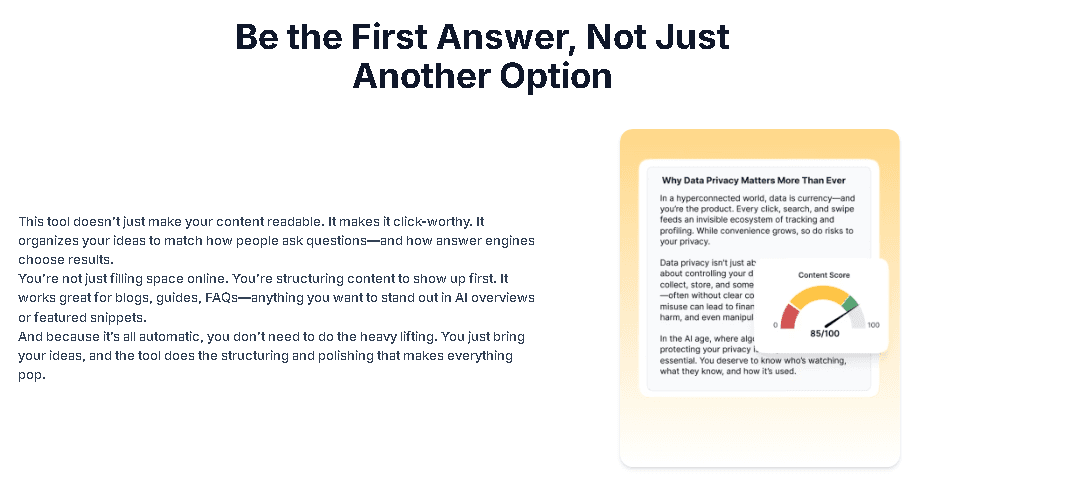
🧠 Why AISEO Stands Out for Content Creators
Unlike generic AI writers, AISEO:
- Helps your content rank, not just exist
- Humanizes text without losing SEO keywords
- Builds topical authority automatically
- Optimizes for both Google Search & AI Overviews
- Performs like an SEO expert working beside you
Perfect for bloggers, agencies, and business owners growing fast.

💰 Pricing

💡 Scale plan is ideal once your content cadence increases.

3. AirOps
No matter how advanced your AI stack is, few platforms tie content creation, optimization, and AI-search visibility together as seamlessly as AirOps. While most AI content tools focus on writing faster, AirOps focuses on writing smarter — ensuring your content wins in both Google and emerging AI-answer engines.

💡 Pro-tip! AirOps is used by growth teams at Webflow, Ramp, and Descript — all reporting visibility boosts and measurable traffic gains after refining their content operations through the platform.

⚙️ What’s There for Content Creators?
AirOps functions as a complete content-operations suite, helping teams structure, optimize, and distribute content that ranks and gets cited by AI systems. It’s the tool you use when you want your brand to appear in AI Overviews, ChatGPT citations, and featured snippets — not just search results.
🛠️ AI-Search Visibility
AirOps lets you monitor exactly how your content performs in AI answer engines. You can track visibility by topic, funnel stage, region, and persona, giving you data to act on — not guesswork.
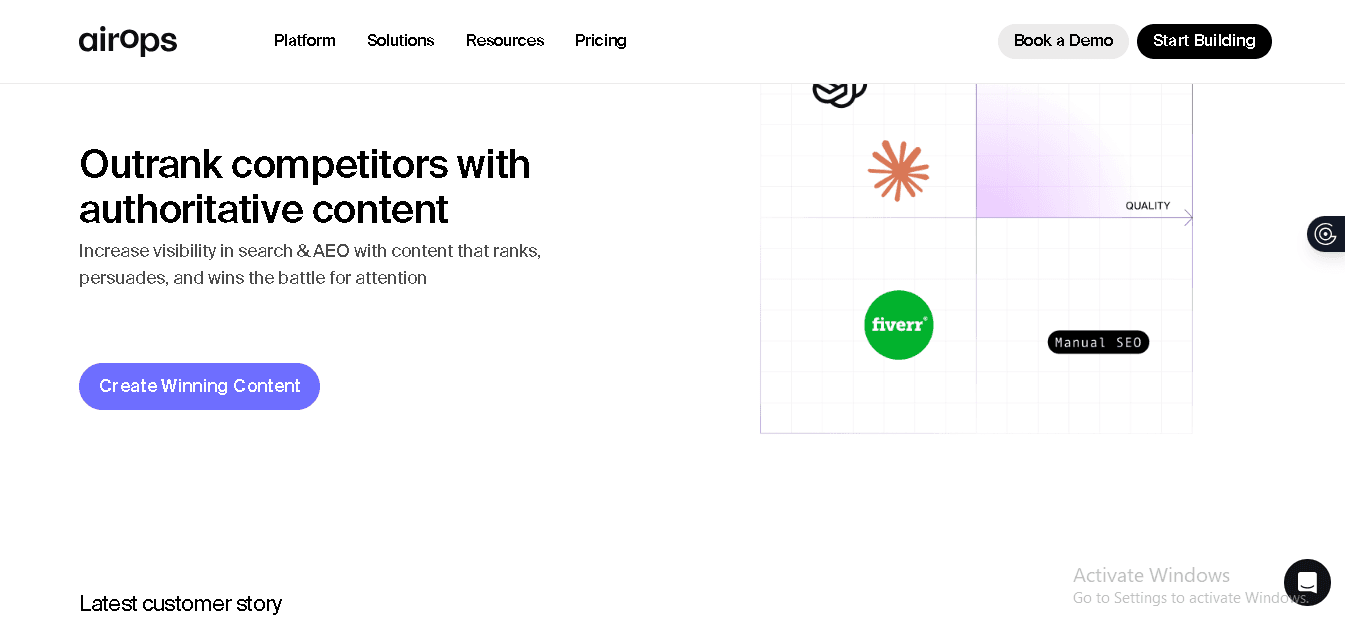
🧩 Workflow Automation
Unlike generic AI writers, AirOps uses drag-and-drop workflows that take you from research → writing → review → publish → refresh — all in one place. These pipelines are perfect for agencies managing multiple content streams.
🧠 Brand Alignment
Its Brand Kits keep tone, compliance, and messaging consistent. Whether you’re producing blog posts, landing pages, or educational content, every piece follows the same voice — no rogue phrasing or off-brand tone.
🚀 Optimization for Authority
AirOps automatically structures content to win featured snippets and AI citations by integrating schema, FAQs, and competitive keyword insights.
💡 Pro-tip! Research from AirOps shows that pages refreshed every 12 months or less earn up to 70% more citations in AI search — a compelling reason to keep your content updated.
💰 Pricing
AirOps offers flexible pricing that scales with your team’s growth.


💡 Pro-tip! You can activate a 14-day free trial of the Scale plan before committing — an easy way to test visibility insights and automation at no cost.
🎯 Best For
- Marketing teams building content at scale
- Agencies handling multiple clients with strict brand guidelines
- Enterprises tracking their visibility in AI and search engines simultaneously
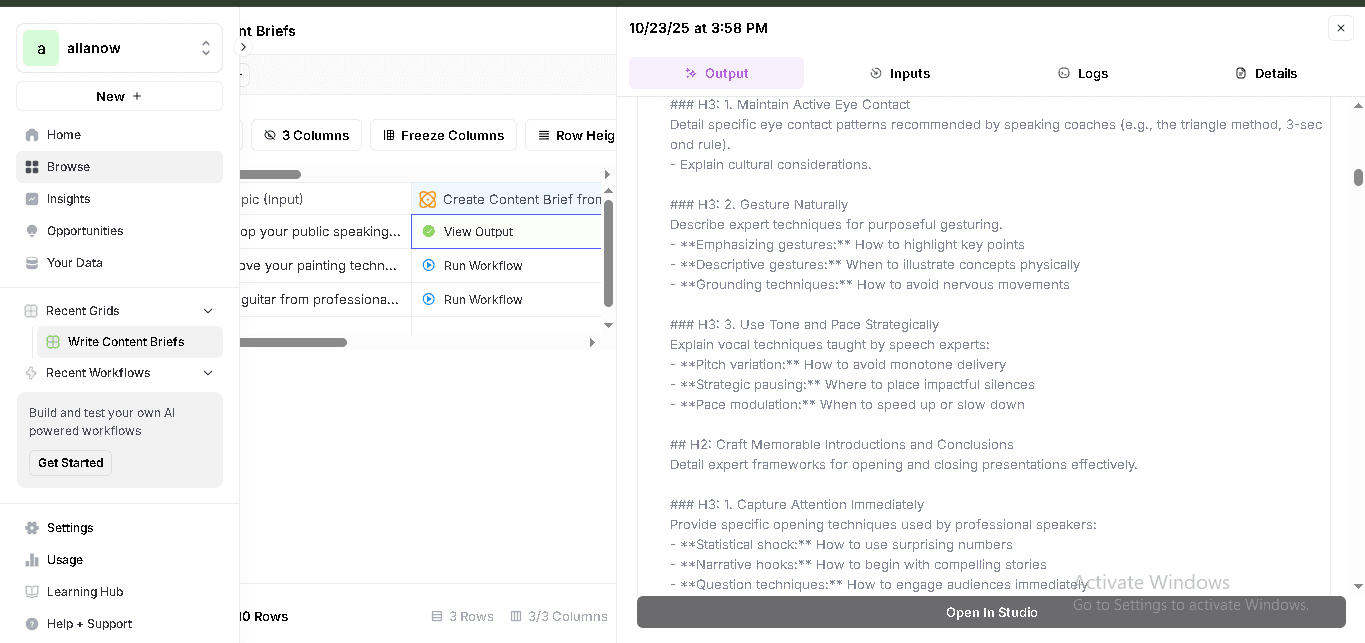
💎 Bonus: Why AirOps Stands Out
What makes AirOps unique is its “insights → action” loop. It doesn’t stop at analytics — it tells you where your content is losing visibility and gives you precise, page-level actions to fix it. Most AI tools can create; AirOps ensures that creation actually converts.

4. ChatGPT
Among all AI content creation tools, ChatGPT stands as the most widely recognized and versatile. Developed by OpenAI, it powers millions of writers, marketers, and creators — from brainstorming blog ideas to generating visuals, scripts, and data-driven reports. While many platforms focus on niche functions, ChatGPT dominates through creative flexibility and its ability to adapt to nearly any content workflow.

💡 Pro-tip: With the latest GPT-4-Turbo model and Custom GPTs, ChatGPT has transformed from a conversational AI into a full-fledged AI content creation suite capable of producing, optimizing, and visualizing content all in one place.
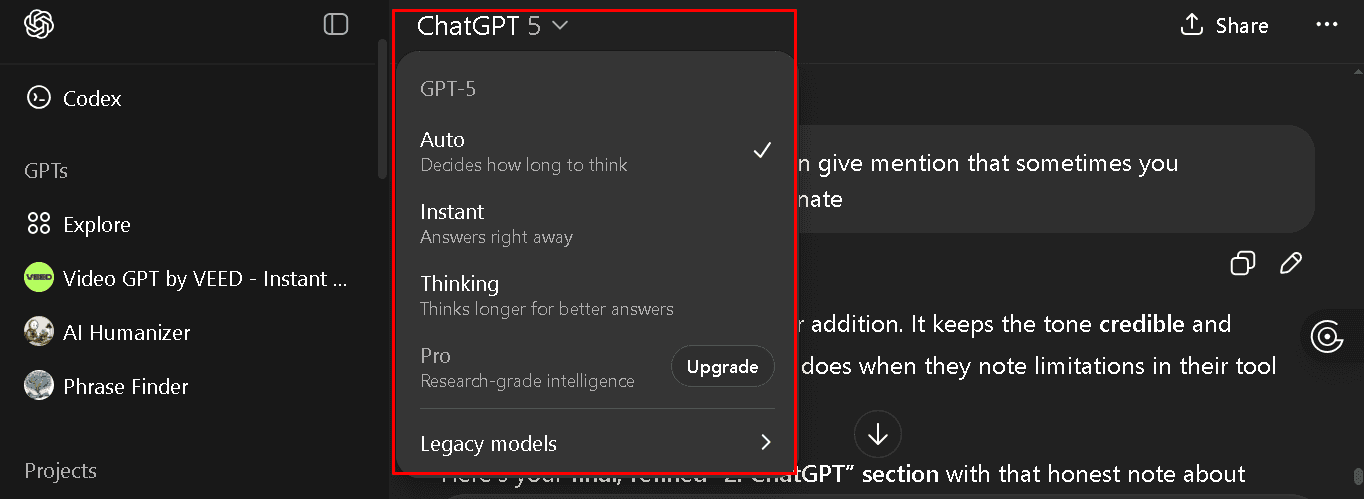
⚙️ What’s There for Content Creators?
ChatGPT redefines what users expect from modern AI content creation tools. It helps you handle every part of the creative cycle — from ideation and outlining to visual design and publication.
🧩 Content Ideation and Outlining
Need fast topic ideas or keyword-based outlines? ChatGPT generates full content frameworks, editorial calendars, and blog structures in seconds. You can also prompt it to research trends, suggest angles, or align ideas with SEO intent.
✍️ Drafting and Editing
It can write blog posts, email campaigns, ad copy, and even video scripts while matching your tone and style. You can fine-tune prompts for brevity, structure, or storytelling — giving your content that human-sounding polish audiences expect.
🧠 Data-Driven Optimization
With GPT-4-Turbo, you can upload files or URLs for summary, rewrite, or fact analysis. It identifies clarity issues, improves readability, and adjusts phrasing for higher engagement. When browsing is active, it can even pull real-time stats for more accurate data.
🖼️ Text + Image Creation
Unlike most AI content creation tools, ChatGPT also supports image generation. You can create blog visuals, infographics, and social media graphics directly within the chat. This dual capability — writing and design — makes it a one-stop creative companion for individuals and marketing teams.

💡 Pro-tip: Use Custom GPTs to automate your workflow. For instance, set up a “Blog Strategist GPT” for SEO writing or a “Visual Designer GPT” for consistent branding.
💰 Pricing

💡 Pro-tip! The Team plan is ideal for agencies managing collaborative projects — it supports shared GPTs, secure data, and scalable creative production.
⚠️ A Note on Limitations
While ChatGPT is one of the most capable AI content creation tools, it can still hallucinate — generating inaccurate or outdated facts. Always review and fact-check key details before publishing.

🎯 Best For
- Freelancers and writers managing diverse content needs.
- Marketing teams producing blogs, scripts, and social campaigns.
- Agencies handling large content volumes and visual assets.
- Businesses automating documentation, guides, or communication.
💎 Why ChatGPT Stands Out
ChatGPT stands out for its breadth and multimodal power. It’s not only a text generator — it’s an AI content creation tool that can write, edit, analyze, and design all in one place. From generating keyword-optimized blogs to producing matching visuals, it bridges creativity and strategy seamlessly.
Unlike single-purpose tools, ChatGPT serves as a central creative hub, uniting text and visuals under one workflow. Whether you’re a solo creator or a full-scale marketing team, ChatGPT gives you speed, versatility, and cross-format consistency — provided you guide it with human insight and editorial judgment.

5. Jasper AI
Among all AI content creation tools, Jasper AI remains a standout for professional marketers and agencies that prioritize quality, structure, and branding. It’s a platform designed not just to write—but to think and create at the pace of your business.
💡 Pro-tip: Jasper combines writing, design, and optimization in one workspace—letting you create SEO-friendly blogs, social posts, visuals, and ads that all share the same tone and branding consistency.

⚙️ What’s There for Content Creators?
🧩 50+ Templates for Every Workflow
With over 50 specialized templates, Jasper helps users generate blogs, ads, emails, and video scripts effortlessly. Its Long-Form Assistant and Boss Mode are perfect for writing complete articles or reports, while the built-in Commands feature lets you control Jasper conversationally.
🖋️ Jasper Chat
Similar to ChatGPT but built for marketers, Jasper Chat understands context, tone, and brand style. You can ask it to rewrite emails, generate ad copy, or plan content calendars—and it remembers your preferences for future projects.
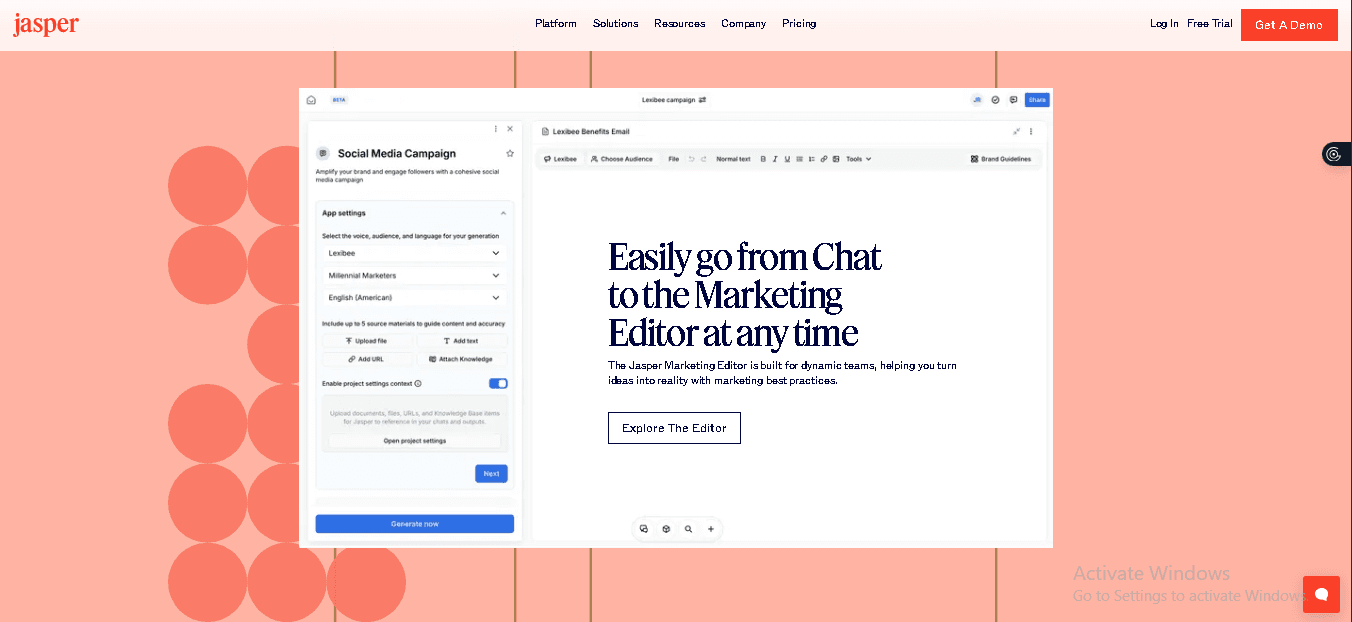
🎨 Jasper AI Image Suite
The Jasper AI Image Suite turns image editing into a lightning-fast creative superpower. Instantly refresh thousands of visuals, swap backgrounds, or upscale detail—all with simple prompts. Perfect for seasonal campaigns, it keeps brands like Adidas and Ulta ahead with studio-quality images, faster launches, and zero creative bottlenecks.

🔍 Surfer SEO Integration
For writers focused on ranking, Jasper’s integration with Surfer SEO ensures content meets keyword and structure goals. The live scoring feature helps improve SEO before you hit publish.

💻 Chrome Extension
With Jasper’s Chrome extension, you can use its AI power in Google Docs, WordPress, Gmail, or even social schedulers like Hootsuite and Sprout. That means smoother workflow, no matter where you write.
💳 Billing & Pricing

🧾 Pro Plan Billing Details
- Plan: Pro
- Trial: 7 days free — You won’t be charged until the trial ends.
- Billing: $59 per seat/month, billed annually ($708 per seat total).
- Payment: Secured by Stripe.
- Discount: Save 14% with annual billing.
- Taxes: Applied at checkout if applicable.

💡 Note: Jasper requires you to enter your card details upfront to activate the trial. This can be a slight drawback compared to other AI content creation tools like ChatGPT or AirOps, which let users test the platform freely before adding payment info. While Jasper assures no charge until the 7-day trial ends, some users prefer a more open-access approach during testing.

⚠️ A Note on Limitations
Although Jasper is exceptional in speed and brand accuracy, it still needs human supervision for fact-checking. Its AI outputs are strong but not perfect—especially for technical or data-heavy content.
🎯 Best For
- Marketing teams building brand-consistent content.
- Agencies managing multi-client SEO and campaigns.
- Freelancers handling diverse content projects.
- Businesses seeking visual and written AI output in one dashboard.
💎 Why Jasper Stands Out
Jasper’s all-in-one combination of text, visuals, SEO, and brand voice learning puts it a step ahead of other AI content creation tools. It isn’t just a writing assistant; it’s a full creative system that helps teams produce polished, on-brand material quickly.
While ChatGPT excels in versatility, Jasper shines in marketing precision, scalability, and content quality. It’s the tool you choose when brand consistency and SEO performance matter as much as creativity itself.
6. Writesonic
If AI content creation tools were ranked by versatility, Writesonic would earn a top spot for marketers who need both writing and automation in one platform. Created in 2020, it quickly evolved from a basic content generator into a full-blown marketing assistant with features tailored for agencies, entrepreneurs, and small businesses.
💡 Pro-tip: Writesonic markets itself as your “AI marketing agent,” handling everything from blogs to ad campaigns while staying SEO-friendly and brand-consistent.

⚙️ What’s There for Content Creators?
🧠 AI Article Writer 6.0
This is Writesonic’s flagship tool — it creates long-form, SEO-optimized blog posts in minutes. Its strength lies in marketing-ready content, not just generic AI writing. You can specify tone, keywords, and structure, and the AI will build a well-formatted article ready for publication.

💬 Chatsonic
A conversational assistant similar to ChatGPT but powered by Google Search integration, meaning it can reference real-time information. Ideal for trend-based content, product updates, or social media copy that needs up-to-date data.

🤖 Botsonic
Lets you build custom AI chatbots for your website — perfect for lead generation or customer support without coding.

👤 SocialSonic
Focused on personal branding, especially on LinkedIn, SocialSonic helps write engaging posts, comments, and outreach messages tailored to your professional audience.

💰 Pricing and Plans
Writesonic’s pricing caters to creators and marketing teams of all sizes, starting with a free plan that doesn’t require a credit card.
Plan

💡 Pro-tip! The free plan lets you test Writesonic’s SEO and content tools instantly — no card required. However, AI Search Visibility (GEO tracking) is only available on Professional and higher tiers.
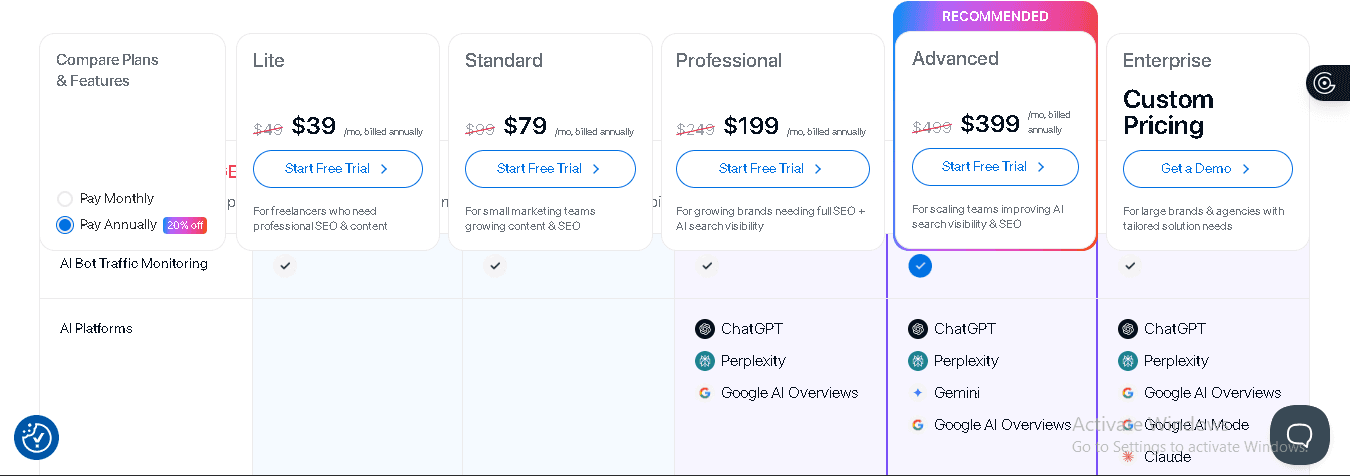
⚠️ The Downsides
While Writesonic’s automation and SEO integration are impressive, it’s not flawless. Some users report billing hiccups and slow support when canceling subscriptions — an area where the platform still needs refinement. It’s also more tailored to marketing and SEO, not academic or technical writing.
💎 Why Writesonic Stands Out
Writesonic’s edge lies in speed and marketing focus. Its multi-tool ecosystem — from Chatsonic to Botsonic — gives marketers an end-to-end workflow without needing external apps. The real-time data access also makes it smarter for campaign-based writing than most AI content creation tools.
If your priority is marketing content, SEO writing, or social posts at scale, Writesonic offers one of the most balanced combinations of automation, creativity, and accessibility.
7. Copy.ai
Once a simple writing assistant, Copy.ai has evolved into a full-fledged GTM (Go-To-Market) AI platform built to streamline both sales and marketing operations. Unlike traditional AI content creation tools that just produce copy, Copy.ai connects your entire funnel — helping teams generate content, automate outreach, and even forecast deals, all from one place.
💡 Pro-tip! Copy.ai isn’t just for writing — it’s for executing. It combines AI writing power with sales automation so you can generate, personalize, and deploy campaigns at scale.

⚙️ Key Features That Set It Apart
🧠 AI-Powered GTM Automation Copy.ai merges marketing content creation with sales process automation. Its pre-built “agents” can generate copy, schedule follow-ups, and assist with lead qualification — almost like having a small AI sales team.

🧩 Actions & Workflows System You can string together multiple “Actions” like Generate → Rewrite → Improve → Follow-up, automating full campaign sequences from email to outreach.
🗣️ Brand Voice & Context Control Users can define tone, upload content references, and train Copy.ai on their brand materials for consistent, on-message writing — something generic AI tools can’t replicate.
🔗 Integrations & Compatibility The platform integrates seamlessly with CRMs, project tools, and Zapier, meaning you can manage your marketing and sales operations without switching apps.
⚙️ Copy.ai Agents Copy.ai’s “Jason” agent is particularly popular — it automates outreach and follow-ups, helping teams save 20+ hours weekly while booking more meetings.

💰 Pricing and Plans
Copy.ai’s pricing is simple, transparent, and designed for growing businesses that want scalability and team collaboration.
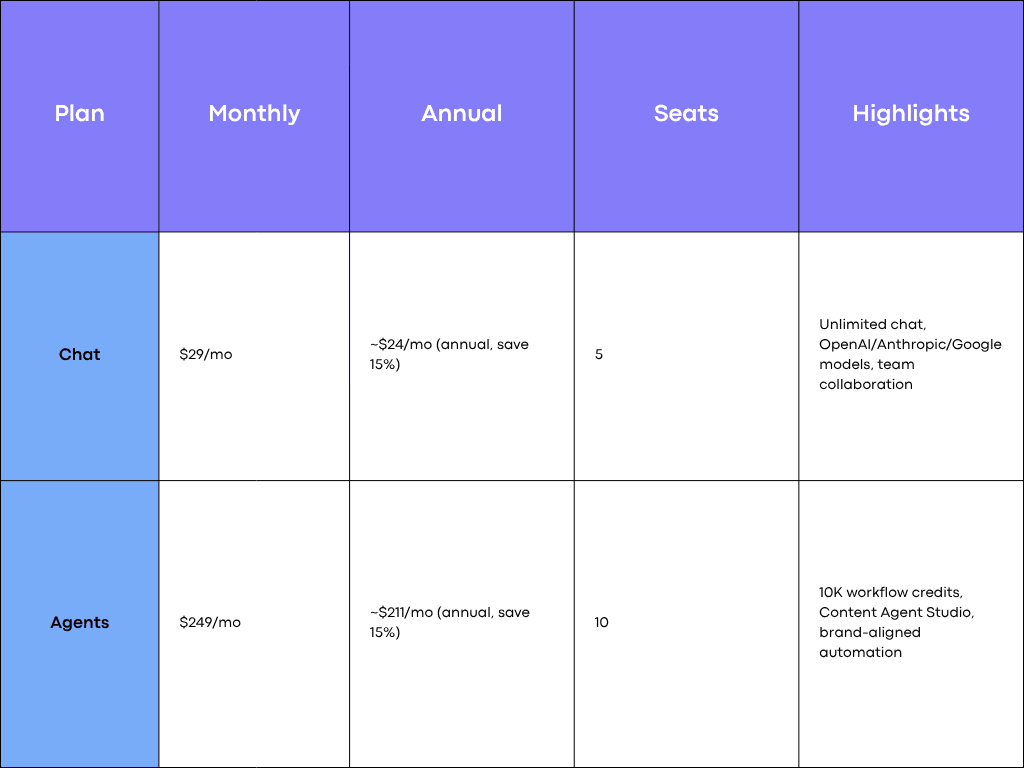
💡 Pro-tip! Copy.ai’s Chat Plan gives you access to multiple AI models and unlimited chat usage — ideal for startups. But if you want advanced automation or to scale content workflows, the Agents Plan unlocks the full Content Agent Studio and workflow system.

⭐ Real User Impressions
Copy.ai earns praise from marketing professionals who love how quickly it generates ready-to-use sales emails, blog intros, and product copy. On G2 and Trustpilot, users highlight its workflow flexibility, ease of use, and time savings — especially for sales teams managing large-scale outreach.
However, there are trade-offs:
- Blog content still benefits from human editing for nuance.
- The $249 Agents tier can feel pricey for freelancers.
- Workflow setup may take time to master for new users.
Despite these, most reviews agree that Copy.ai strikes a powerful balance between automation and creativity — bridging the gap between writing and execution.
💎 Why Copy.ai Stands Out
In 2025, Copy.ai stands apart from most AI content creation tools by going beyond copy generation. It’s a GTM execution engine, not just a text generator. Its real power lies in combining marketing, writing, and automation into one system that learns your brand voice and acts on your behalf.
For growing marketing or sales teams, it’s an all-in-one tool that helps you write less and close more.
💡 Pro-tip: If you want a writer that doubles as a virtual SDR, Copy.ai’s Agent plan is one of the best options in the AI market today.
8. Rytr
Launched in 2021, Rytr positions itself as one of the most accessible and budget-friendly AI quality content without paying enterprise-level prices.
While most tools chase complex automation or long-form generation, Rytr thrives on simplicity — offering over 40 use cases, a built-in plagiarism checker, and even an AI image generator, all within an intuitive, beginner-friendly interface.writing assistants. It’s designed for individuals, freelancers, and small teams who need quick,
💡 Pro-tip: Rytr is perfect for short-form content. Think emails, product descriptions, ad copy, and blog outlines — it’s built for speed and everyday usability rather than technical depth.

⚙️ Key Features That Set It Apart
🧠 40+ Writing Use Cases Rytr can generate everything from blog ideas and outlines to ad copy, cover letters, YouTube descriptions, and even poems. It’s ideal for marketers juggling multiple content types daily.

✍️ Smart Text Editor & Commands Its in-app editor lets you rephrase, expand, shorten, or continue text automatically — powered by contextual AI. You can also check for plagiarism, format text, or append new sections with a click.
🔍 SERP & SEO Integration With a built-in SERP keyword analysis powered by Semrush, Rytr helps users align generated content with search intent. It’s basic, but useful for light SEO optimization.

🧾 Writing Profiles A standout feature — writers can build public profiles to showcase AI-assisted or custom work, turning Rytr into a mini portfolio hub for freelancers.
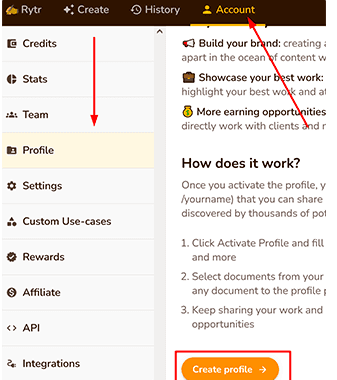
💬 Browser Extension & API Access Rytr’s Chrome extension lets you write anywhere (Gmail, LinkedIn, WordPress), while its API supports custom integrations for businesses.

💰 Pricing and Plans
Rytr’s biggest draw is affordability — it offers one of the most cost-effective pricing models in the AI writing market.


💡 Pro-tip! Rytr’s Free plan is one of the most generous in the market — no credit card required, perfect for testing before you commit.
⭐ Real User Impressions
Rytr scores highly across platforms like G2 (4.9/5) and Capterra, with users praising its simplicity, affordability, and versatility. Writers appreciate its balance of speed and functionality — it can generate usable drafts in minutes.
However, there are caveats:
- Long-form writing lacks consistency beyond 1,000 words.
- The UI, while simple, could use modernization.
- Integration options remain limited compared to larger tools.
Still, for small teams and solopreneurs, Rytr delivers exactly what it promises — reliable, quick content creation at minimal cost.
💎 Why Rytr Stands Out
In 2025, Rytr remains the go-to choice for short-form AI writing. It’s not trying to replace professional editors or SEO suites — instead, it focuses on empowering everyday users with clean, affordable, and accessible AI writing support.
Its AI image generation, plagiarism detection, and multi-language support make it especially useful for freelancers, marketers, and agencies managing diverse clients.
💡 Pro-tip! If you need a dependable, no-fuss AI writer that helps you generate quick, on-brand copy without breaking the bank — Rytr’s Unlimited Plan is the sweet spot.
Suggested Workflow: How to Use AI Tools Smartly in 2025
Here’s a workflow you might adopt to get better results:
- Outline & research Use ChatGPT to generate a content brief, subheading structure, and research pointers.
- Draft generation Use Jasper, Writesonic, or Copy.ai to generate a draft under your guidance (feeding context, points, tone).
- Edit & inject voice Manually edit: add stories, context, transitions, formatting, humor, visuals.
- Humanize / polish Run the full draft using AISEO AI or Humanize AI Text to smooth unnatural phrasing, reduce robotic tone, and bypass detectors.
- Final pass & publish Proofread, check facts, add images, and publish. Monitor engagement. Use data to refine prompts next time.
Over time, your prompts and use of AI will improve — leading to faster, better results.

Conclusion
As we move deeper into 2025, one thing is clear — AI content creation tools are no longer futuristic experiments; they’re everyday essentials for writers, marketers, and businesses. From brainstorming to SEO optimization, these platforms are redefining how ideas turn into high-performing digital content.
Yet, the real power of these tools doesn’t lie in automation — it lies in collaboration. The best results happen when human creativity meets AI precision. You guide the strategy, tone, and emotion — the AI takes care of speed, structure, and scalability.
Whether you’re using ChatGPT for ideation, Frase for SEO, Writesonic for fast output, Humanize AI Text or AISEO for humanizing your drafts, each step brings you closer to content that not only ranks but also resonates.
As you embrace these tools, remember: AI can write, but only you can tell the story. Let technology enhance your voice, not replace it — and you’ll stay far ahead in the content game.
Frequently Asked Questions About AI Content Creation Tools
1. What are AI content creation tools?
AI content creation tools are software powered by artificial intelligence that help writers, marketers, and businesses create written content more efficiently. They can generate blog posts, social media captions, product descriptions, and even long-form articles. Modern tools also include editing, SEO optimization, and tone customization features to ensure content quality and consistency.
2. Can AI tools completely replace human writers?
No. While AI content creation tools are excellent at generating ideas and first drafts, they lack human creativity, empathy, and deep contextual understanding. The best results come from combining AI efficiency with human insight, editing, and storytelling skills.
3. Which AI content creation tool is best for SEO-focused writing?
Tools like Frase and AirOps excel in SEO optimization. They analyze search intent, keyword trends, and top-ranking content to help you craft articles that perform better in search results while maintaining readability and structure.
4. How can I make AI-generated content sound more human?
Even the best AI-generated drafts can sound mechanical. That’s where tools like AISEO and Humanize AI Text come in. It refines tone, adjusts rhythm, and restructures phrasing so your content reads naturally and passes AI detection tools with ease.
5. Are AI content creation tools expensive?
Not necessarily. Most tools offer free or affordable plans for individual creators, while premium subscriptions unlock advanced features such as team collaboration, SEO insights, or custom workflows. Whether you’re a solo blogger or managing a large content team, there’s an option that fits your budget.
6. Do AI tools help with editing and proofreading?
Yes, many platforms like Jasper, Copy.ai, and Rytr include editing and grammar correction features. They enhance clarity, tone, and engagement—saving time while improving overall writing quality.

About Dilyar Buzan
Founder & CEO at AISEO
Artificial Intelligence - University of Amsterdam
LLM engineer
